Before starting a photography blog, you need to establish your specific blogging goals. Common goals include promoting your photography services or selling photos, photography equipment, or photography courses. When considering how to start a photography blog, identifying your ideal blog audience and choosing the right blogging platform are keys to your blogging success.
You need a blogging platform that makes it easy to create an attractive, effective photography blog. WordPress is among the most popular blogging platform for photography bloggers and DreamHost is the most flexible and affordable hosting solution. DreamHost plans start at just $2.59 a month. Visit DreamHost today.
Here are the seven steps for starting a photography blog:
1. Establish Your Goals for Starting a Photography Blog
Most people who launch a photography blog do so to either showcase their photography or make money. If you’re starting a photography blog to showcase your work, then your primary task is to select a website builder that makes it easy to display your work. If you’re starting a photography blog to make money, you need to think through how you plan to monetize your blog.
Ways to Make Money with Your Photography Blog
There are several ways to make money with your blog. When learning how to start a photography blog, it’s wise to consider the type of monetization strategies that will work best for you.
Sell Your Photography Services
The most common way photography bloggers earn money is by promoting and selling photography services. You can blog about all types of photography topics such as tips for perfect wedding photos, what to wear in group photos, creative ways to photograph your baby, or how to take model-caliber photos.
Most photographers use their own photos to illustrate their blog posts. Great photos can lead to more people buying your photography services.
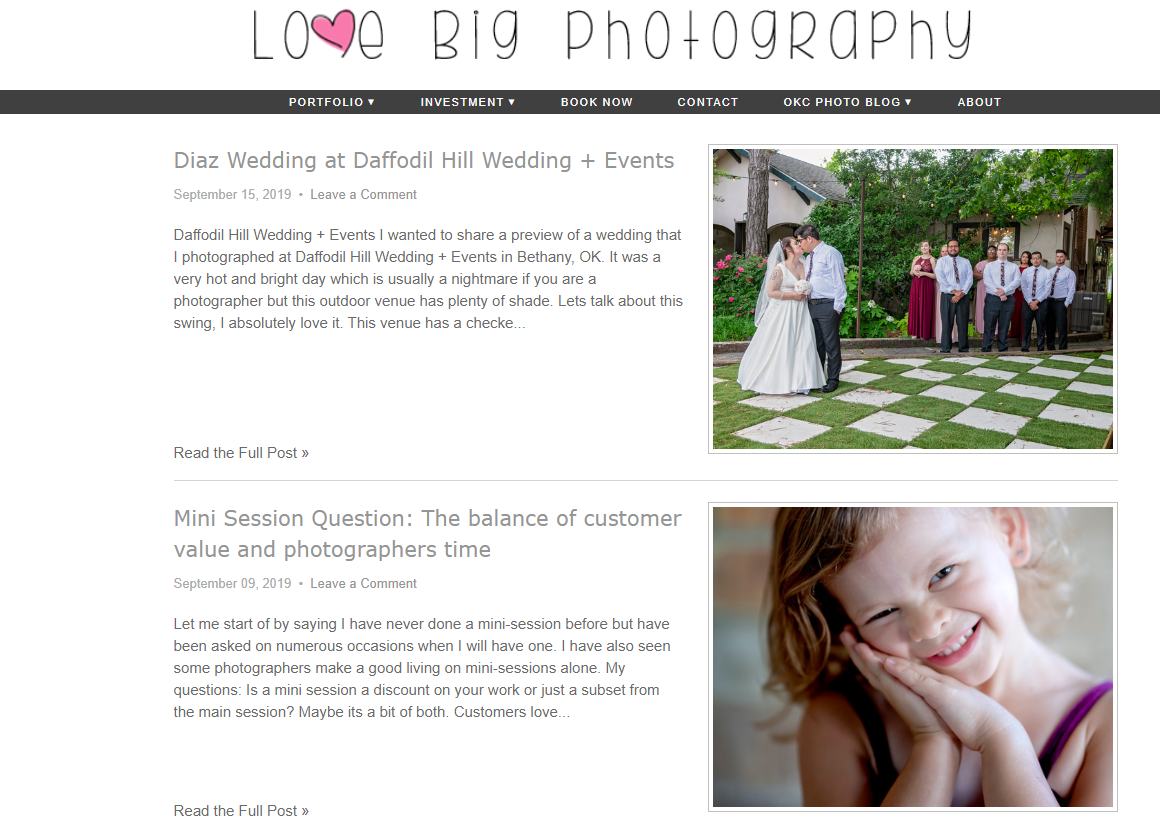
Love Big Photography uses its blog to showcase its photography services and offer photography tips
Make Money with Affiliate Marketing
Many photography bloggers write camera and photography equipment review posts to help their audience make better photography equipment buying decisions. These photography bloggers join affiliate marketing networks and programs, such as Amazon Associates, and then add affiliate links to recommended products in their blog posts.
With affiliate marketing, bloggers earn a commission from affiliate partners every time one of their blog readers make a purchase from an affiliate link. Since photography equipment can be expensive, you can earn hundreds or even thousands of dollars each month through affiliate marketing. The amount you’ll make depends on both what products you recommend as well as the total traffic you generate for your photography blog.
Sell Your Photos to Make Money
Selling or licensing your photos is another way to make money on your photography blog. There are a number of ways to sell your art online. You can create an ecommerce-enabled site and sell directly through your website or you can work with print-on-demand vendors such as CG ProPrints or Printful to sell your photography on your blog. On average, photography bloggers charge between $20 and $150 per photo sold.
Monetize Your Photography Blog with Advertisements
Some photography bloggers choose to add advertisements to their blogs as a way to make extra money. You’ll need a fair amount of traffic—typically north of 25,000 visitors a month—to make much money through advertising. Popular advertising networks you might want to join include Google AdSense, Media.net, and Mediavine. Bloggers average between $10 and $1,000 per month through blog ads.
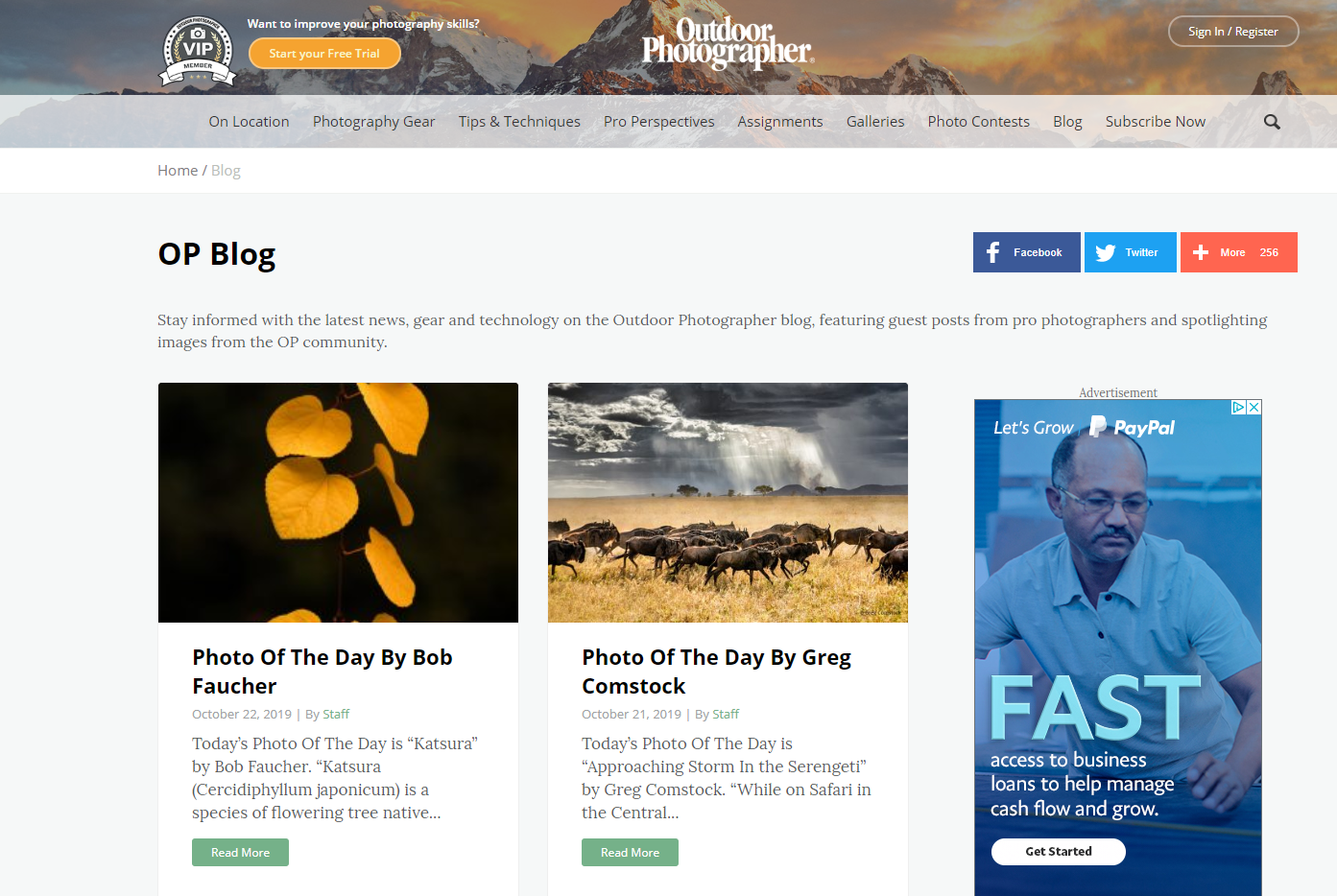
The Outdoor Photographer blog uses Google AdSense ads to help monetize its blog
Create Sponsored Posts to Make Money
You could start creating sponsored posts to monetize your photography blog. Many popular brands hire bloggers to write about their products. If you’re interested in monetizing your photography blog through sponsored posts, you may want to join an influencer network that connects brands to bloggers. BlogMeetsBrand, Real Clever, and TapInfluence are all popular influencer networks to consider. Expect to earn $40 to $300 for sponsored blog posts; top bloggers can earn thousands.
Create & Sell Photography Courses
Some photography bloggers make money by creating and selling online or in-person photography courses. For example, you could teach people how to take better photos, how to edit their photos, or how to use their DSLR camera more effectively. You can easily charge from $50 to $300 for photography courses, depending on the type and length of the course.
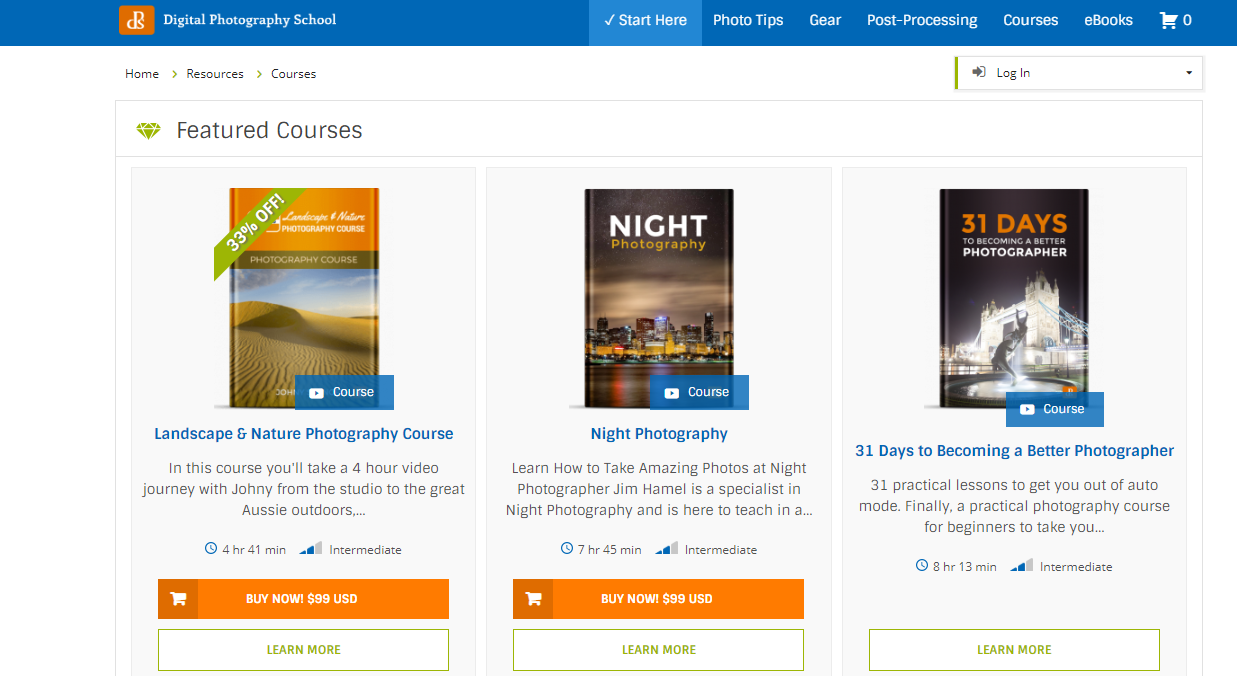
Darren Rowse, founder of The Digital Photography School, started his site as a simple blog and he now sells several online photography courses
Select Your Target Audience for Your Photography Blog
The audience for your blog will be determined by your blogging goals. For example, if you want to make money with photography services, your audience will likely be people in your area who are searching for a photographer. Or, if your goal is to make money through affiliate marketing, your audience may be anyone online who is searching for information on photography equipment and cameras.
It’s important that you identify precisely who your target audience is so that you can create an on-target search engine optimization (SEO) strategy. This will help ensure that your ideal audience will find your photography blog when they’re searching online for the services and information you provide.
2. Choose & Purchase Your Photography Blog’s Domain Name
Selecting a domain name is an essential step in learning how to start a photography blog. You can purchase a domain through your paid blogging platform, such as Squarespace, or hosting service, such as DreamHost. You can also obtain your domain through a site that specializes in selling and registering domains such as Domain.com and Namecheap.

You can purchase a .com domain on Domain.com for as low as $9.99 per year
3. Select a Blog Platform & Hosting Service
There are a number of blogging platforms available today, in fact, so many that it can be confusing. Two of the most popular ways to build a photography blog are through a self-hosted WordPress site or an all-in-one Squarespace website. Some photography bloggers prefer to choose platforms that were developed specifically for professional photographers such as SmugMug or Zenfolio. It’s important to choose the blog platform that will work best for your unique needs and goals.
Create a Self-Hosted WordPress Blog
Building a self-hosted WordPress website is one of the most flexible and economical ways to create your photography blog. More than a third of all blogs and websites on the internet are built with WordPress, which is a free content management system (CMS) that offers a high level of customization and versatility.
If you want to monetize your photography blog, going with the self-hosted, WordPress.org version of the platform allows you to add ecommerce functionality to your site. You’ll need a reliable hosting provider; DreamHost will host your WordPress photography blog for as low as $2.59 per month.
Another popular platform that many photography bloggers use is Squarespace. This blog-builder is an all-in-one solution, which means you don’t have to secure separate hosting services. Squarespace is best-known for its stunning, award-winning template designs, which is one of the main reasons so many photography bloggers flock to this platform. Basic plans start at $12 per month and ecommerce plans start at $26 per month.
Professional Photographer Website Platforms
Some people prefer to create their blogs with a website builder designed specifically for professional photographers. While these builders don’t typically offer the robust SEO functionality and customizability available through WordPress and Squarespace, the ecommerce functions are tailored specifically toward photography bloggers. This makes it easy to get started selling your services while protecting your photos with custom watermarks.
Photographer-centric website builders also typically offer private portals so your photography clients can view images from photo shoots securely and place print orders easily. Two popular photography blog builders are Zenfolio and SmugMug; both are all-in-one builders that do not require separate hosting services.
Zenfolio is a photographer site builder for bloggers that lets you showcase and sell your photography. Professional plans on Zenfolio range from $20 to $30 per month.
The professional version of SmugMug is an all-in-one builder that lets you showcase, share, and sell your photographs and photography services. The Pro plan costs $360 per year or $41.99 when paid monthly.
If you’re starting a photography blog to support your photography services business or sell photos, Zenfolio and SmugMug are suitable platforms for your business needs. If your blogging goals include incorporating advertising, sponsored posts, affiliate marketing, or selling photography courses on your blog—or if you plan to sell photography equipment—a self-hosted WordPress blog or an ecommerce-enabled Squarespace blog are better choices for you.

The Aries template on Zenfolio is a popular choice for professional photographers who want to both sell photography services and blog about photography
4. Design Your Photography Blog
Once you’ve decided on a blog domain and selected your blogging platform and hosting provider, it’s time to start designing your blog. When starting a photography blog, it’s important to keep in mind that you need to create a strong visual presence online while still adding enough SEO-rich keywords in your blog copy so that your target audience will find you online.
How you’ll design your blog will depend on the blogging platform you’ve chosen. For example, if you choose Squarespace as your blogging platform, you’ll select one of its award-winning templates to create your blog design.
The Squarespace Wells template was tailor-made for photography bloggers, but it’s not your only option. The Avenue, Ishimoto, and Wexley Squarespace templates are also popular with photography bloggers. All Squarespace templates can be tailored to your taste using a simple drag-and-drop editor.

The Squarespace Wells’ template was tailor-made for photography bloggers
If you decide to create a self-hosted WordPress blog with DreamHost, you have several blog theme options to select from for your photography blog. Dreamhost offers four photography themes that many photography bloggers use. There are also dozens of photography blog templates you can purchase from top WordPress template sellers such as Colorlib.

The Soledad WordPress theme from Colorlib is popular with photography bloggers
If you decide to use either Zenfolio or SmugMug as your platform, you’ll design your blog using one of the templates available on these sites. While design customization is limited with these builders, the templates provided are geared toward professional photographers who sell photography services or want to sell their photos.
If you’re starting a photography blog to support your professional photography business, you’ll find that both Zenfolio and SmugMug allow you to create a modern online presence for your business.
“My advice is to keep your photography blog design professional and clean. When viewers see your blog for the first time, if it doesn’t look professional, clean, and appealing, they won’t recommend it to others or come back. Make sure your photos and captions look professionally done and neat.”
—Lindsey Marx, Content Strategist, Best Company
5. Develop a Content Strategy
When learning how to start a photography blog, many beginning bloggers make the mistake of not creating a specific content strategy and editorial calendar. You need to be clear about what types of content you want to add to your blog. You also need to create a plan for developing and scheduling your blog content.
Content to Include On Your Blog
There are two basic ways you’ll add content on your blog. The first is through your main blog pages and the second is through blog posts. Most photographers have special pages devoted to their photography portfolios, contact and “about me” information, and photography services. Many bloggers also have separate pages devoted to photography products or photos that are for sale or that can be licensed. You’ll want to have your main blog pages set up and at least five to 10 blog posts added before promoting your blog.
The most successful photography bloggers add a new blog post at least once a week to grow their blog traffic and build their blog’s credibility; some add new blog posts daily. You can experiment with how many blog posts work best for you, as not all bloggers have the time required to blog more frequently than weekly or even monthly.
Most site visitors will expect your photography blog to be filled with stunning photographs; however, you don’t want to just use any photos on your blog. It’s important that the photos you use are relevant to the blog post and help convey visually what is difficult to describe through words alone.
Some photography bloggers dismiss the importance of words on their blogs, and that’s a major mistake. If you want to rank high on Google, make sure you include plenty of keyword-rich text on your blog to gain an SEO advantage.
“It might sound obvious, but make sure you’re using the right kind of image to illustrate points in your blog, not just examples of your work. Relevant images could be a shot that showcases the lighting setup you’ve been talking about, or even a screen shot of the setup on your editing software if you’re getting more technical. Resist the urge to just use your prettiest pictures—make sure the photos you use are always relevant to the point you’re making.”
—Becky Kerr, Owner, Becky Kerr Photography
Different Types of Blog Content to Consider
The subjects you’ll cover on your blog will depend on your audience. If you’re not sure what your audience wants to read about, you can visit other photography blogs for inspiration or you can perform keyword research using free tools like Google’s Keyword Planner or Answer the Public.
There are several different ways to format and deliver your blog content. The most successful photography bloggers use multiple content format strategies.
The most popular types of blogging content include:
- Infographics: An infographic is a visual representation of information or knowledge. It helps readers grasp complex concepts easily.
- Videos: You can write about photography all you want, but sometimes a high-impact video can explain your point more quickly than thousands of written words. Plus, people love sharing great videos, so your video blog content has a better chance of going viral.
- Product reviews: Help your blog readers make better purchase decisions by offering reviews on cameras, photography equipment, photo editing software, or photography courses.
- Interviews: Interviews with experts are often a big hit on blogs.
- Blog series: Create a blog series that links several pieces of related content together. This is a terrific way to cover a large-scope subject while keeping your blog readers coming back again and again.
- Listicles: Make a list of top things on a specific topic that will help your reader, for example, 19 things you don’t want to do in your wedding photos.
- How-to content and tutorials: Teach your readers how to do something, for example, how to take better photos in low-light situations.
- Checklists: Create a checklist that readers can download that will prove helpful to them, for example, 11 things you need to do to prepare for family photos.
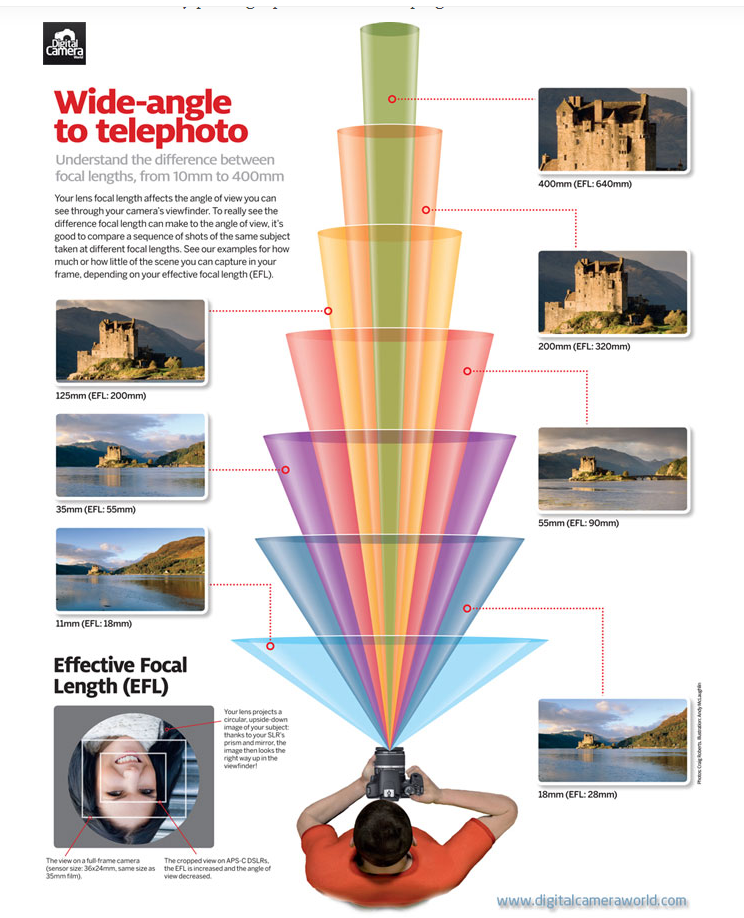
Example of an Infographic created by DigitalCameraWorld.com
Create an Editorial Plan For Your Photography Blog
When starting a photography blog, you may be at a loss for what to write about or you might already be overwhelmed with blog content ideas. Don’t worry; most bloggers go through both of these stages at one time or another.
If you’re not sure what to write about, start visiting popular photography websites and see what they’re including on their blogs. Never directly copy anyone else, but learn from what they do well and what they don’t do well—both will spark ideas for your own blog.
If you’re overwhelmed with blog ideas, it’s important to get all your thoughts organized into an idea list, from which you will create an editorial plan for your blog. You can create a list of ideas for your photography blog on a pad of paper or on a spreadsheet. However, a better way to start organizing your thoughts is to use an online project management tool. You can get started creating your blog content plan with the free version of Trello, a project management software, as in the example below.

Sample Photography Blog Content Plan created on Trello
All project management tools vary a bit in how you establish new projects and organize your tasks. When you use Trello for your photography blog content planning, you begin by creating different lists. In the example above, this sample photography blog content plan contains four lists, with a handful of project cards listed below each list.
Primary list categories to include in your content planning efforts include:
- Photography blog post ideas
- Photography blog posts being written
- Photography blog posts ready to edit and proof
- Content added to the blog
You can add as many ideas to your “blog ideas list” as you’d like, and you can always add even more over time. When you’ve decided that you want to develop a blog post idea, you simply move the idea card over to your “posts being written” category list. You then assign a due date and as well as document pertinent post details within the Trello card. You move cards over to subsequent list categories as you progress through the blog post development and publishing process.
Every post on your photography blog needs to go through a proofing and editing process. While you can do this yourself, your blog will have fewer errors if you use a professional editor and proofreader. You can find these services on Fiverr and pay on between $5 and $75 for blog post editing services. If you’re not confident in your writing abilities, you can also outsource your blog writing to freelancers on Fiverr.

Find blog editors, proofreaders, and writers on Fiverr
6. Launch Your Blog
Once you have at least five to 10 blog posts on your blog, and you’ve created all your primary pages—such as your contact page, portfolio page, and sales or services offered pages—you’re ready to publish your blog. When learning how to start a photography blog, going live is a scary step for many beginning bloggers. But, don’t fret; the beauty of blogging is that you can improve upon your photography blog over time. Never let your desire to be perfect from Day One keep you from launching your blog.
7. Promote Your Photography Blog
Now that your blog is live, you’ll want to take the next, and perhaps most important step in how to start a photography blog: attracting visitors to your website. It doesn’t matter what your specific blogging goals are, getting your target audience to visit your site and take the actions you desire when they’re there is key to running a successful photography blog.
Here are the most popular ways to promote your blog:
- Use social media: You can promote your photography blog by creating accounts on Facebook, Twitter, Pinterest, LinkedIn, and Instagram and actively promoting your blog posts, photos, and services. You can also purchase highly-targeted ads on these social media sites where you can reach your ideal audience with custom messages.
- Focus on email marketing: When visitors come to your blog, make sure you have an email sign-up form where they can join your email list. Email marketing is a terrific way to drive consistent return traffic to your site.
- Advertise on Google: You can create geo-specific, keyword-targeted Google Ads to promote your photography services and your blog. Ad costs average between $1 and $3.50 per click, though prices can be considerably higher in large, competitive markets.
- Guest blog on other photography sites: You typically don’t earn a fee for writing for someone else’s blog, but you can get great exposure in front of a big audience, which in turn drives traffic to your photography blog.
- Create a Google My Business profile: If your photography blog is primarily an avenue for getting more business for your local photography studio, you can set up a free Google My Business profile to promote your business.
- Ask others to recommend your blog: Relationship marketing is one of the best ways to generate more business. Ask loyal clients, friends, and colleagues to recommend your blog to their networks.
- Volunteer to take photos for a local event: Offering to take photos for a local event—especially well-attended nonprofit events—can be an effective way to get your name out for your photography blog and business.
- Engage in online photography forums: Actively participate in online forums that discuss the types of photography subjects you cover on your blog.
Don’t try to pursue too many blog promotion tactics at once; you’ll spread yourself too thin and both the quality of your efforts and the results will be disappointing. Instead, pick a couple of these blog promotion activities to test and see what results they bring. As you become more accomplished promoting your blog, you can then move on to test more tactics.
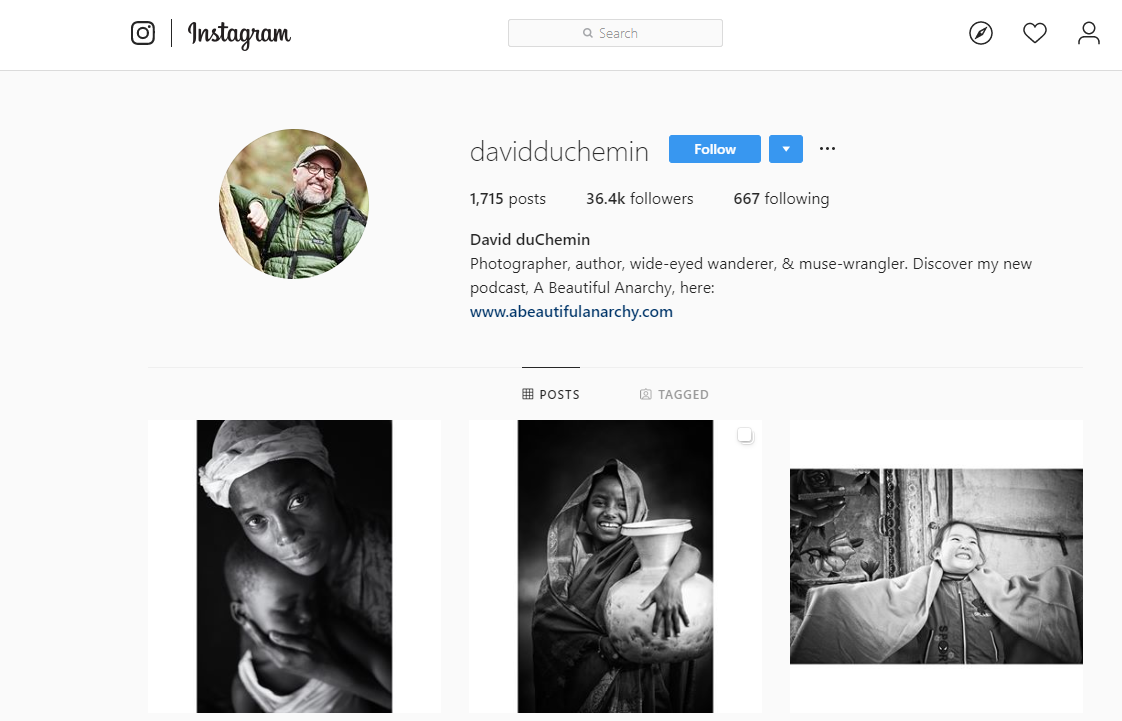
Photographer and author David duChemin uses Instagram to promote his photography blog
Bottom Line – Starting a Photography Blog
When learning how to start a photography blog, you begin by getting crystal-clear about what you want to accomplish. The most successful and most profitable photography blogs include stunning visuals and compelling posts targeted to the blog’s ideal audience. Promoting your blog is the last and most important step in starting a photography blog.
To create a modern, visually stunning photography blog, many bloggers choose to build a self-hosted WordPress website using DreamHost as their hosting provider. DreamHost provides a 100% uptime guarantee and comes with a highly intuitive, instant WordPress installation process. DreamHost plans start at just $2.59 a month. Visit DreamHost today.
Read More


0 تعليقات